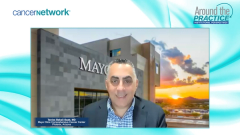
CEA vs ctDNA for Monitoring Patients with Colorectal Cancer
Joleen Hubbard, MD, compares CEA with ctDNA for monitoring patients with colorectal cancer.
Episodes in this series

Transcript:
Tanios S. Bekaii-Saab, MD: Joleen, last piece of the session, CEA [carcinoembryonic antigen] and its level of sensitivity and specificity. Essentially, with what I’m hearing from all of you is that MRD [minimal residual disease] assessment has become more integrated into your clinic. Selectively for some, less selectively for others. How do we make sense of CEA in this setting?
Joleen Hubbard, MD: Great question. Given the data that has been presented and published thus far, I think most of us feel that ctDNA [circulating tumor DNA] can pick things up a little bit better and earlier than CEA for those who have a positive correlation with their cancer and CEA. There’s a good percentage of patients who have metastatic cancer and will have a normal CEA. It’s not a good marker for everybody, and even among those patients where it is a good marker, we have data to suggest that ctDNA ends up being positive sooner than CEA level. We think of it as a better marker for recurrence. How we incorporate this in our practice and how often we check circulating tumor DNA in the adjuvant setting to monitor for recurrence are still unknown questions.
We run into a couple different difficult scenarios where, one, we may have a ctDNA positive test result but nothing on imaging, and then we’re not able to necessarily intervene for a cure, although there are some good clinical trials for MRD-positive patients. It can create a lot of anxiety if patients know that they have a positive level, but we can’t find anything yet. I talk to my patients about that potential anxiety that it may cause, and there are also false negatives where maybe the ctDNA is negative, but we see something on imaging. A lot of that has to do with where the location of the tumor is. We know that the lung sheds less than the liver, etc. So there’s a lot of unknowns [on] how to use this in the adjuvant setting. I have a thoughtful discussion with our patients right now. I try to put those that I can on a clinical trial and then have a discussion for those not on a trial whether we pursue following it in the adjuvant setting, knowing that there may be some difficult circumstances that come up, that we don’t know if we’re improving survival by following patients for MRD and intervening a little earlier.
Transcript edited for clarity.
Newsletter
Stay up to date on recent advances in the multidisciplinary approach to cancer.






















































































